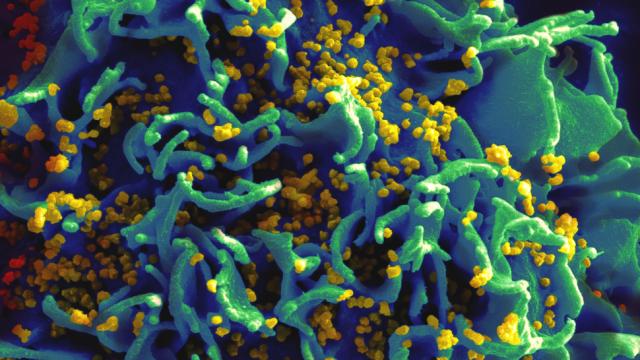An interdisciplinary team of scientists is claiming to have eliminated the HIV virus from the genomes of mice by combining the CRISPR-Cas9 gene-editing tool with an experimental new drug. It’s a promising development in the battle against HIV and AIDS, but more work is required before clinical trials can begin.
Using a gene-editing tool like CRISPR to clear out an infectious disease may seem strange, but HIV is a retrovirus that embeds itself within DNA as a means to replicate. Antiretroviral therapy, or simply ART, can suppress HIV replication, but it can’t eliminate every trace of the disease, as it’s not capable of purging cells in which the virus has gone dormant.
As new research published in Nature Communications shows, CRISPR-Cas9, when used in conjunction with an exciting new form of ART, provided a one-two punch that flushed out the virus from the genomes of a living animal. That’s never been done before.
In experiments on mice that were genetically modified to have certain similarities with humans, a research team led by Kamel Khalili from the Lewis Katz School of Medicine at Temple University in the U.S. eliminated all traces of the HIV virus in slightly more than 30 per cent of infected mice. It’s not a perfect result, but it provides reason to be optimistic.
“We now have a clear path to move ahead to trials in non-human primates and possibly clinical trials in human patients within the year,” said Khalili in a press release.
Khalili, it’s worth pointing out, is the founder and principal scientific advisor of Excision BioTherapeutics, a Philadelphia-based company that uses CRISPR to treat viral diseases.
Excision BioTherapeutics holds the exclusive licence for the commercial application of this new therapy. Nearly 37 million people worldwide are infected with HIV-1, and more than 5000 people are infected each day, according to UNAIDS.
So it makes sense that this team is eager to begin clinical trials, but the new research needs to be met with a hefty dose of caution. In addition to explaining the low success rate, the researchers will need to show that the CRISPR edits aren’t resulting in long-term side effects, such as cancer.
Antiretroviral therapy for AIDS changed the lives of millions, but it’s not a cure in the technical sense. Patients have to take medicines on a regular basis to keep the HIV virus in check, lest it re-emerge in the body and proliferate to dangerous levels.
What we really need is a therapy that completely eliminates HIV from the body, which is precisely what Khalili and his colleagues have been working on for the past several years.
Previously, Khalili’s team showed that CRISPR could be used to excise HIV DNA from infected genomes. But this approach, like ART, wasn’t able to completely eliminate the virus on its own. For the new study, Khalili recruited the help of Howard Gendelman, a professor of infectious diseases and internal medicine at the University of Nebraska Medical Center.
Gendelman has been working on a new approach to ART called LASER, or long-acting slow-effective release. This system targets cellular reservoirs where the HIV virus hides and is capable of suppressing the replication of the virus for extended periods. To do this, the drug is wrapped in nanocrystals, which help it spread to tissues where HIV is most likely to be dormant. Once at the desired location, the nanocrystals can stay inside the cells for weeks, slowly releasing the drug.
This approach to ART caught the attention of Khalili, who “wanted to see whether LASER ART could suppress HIV replication long enough for CRISPR-Cas9 to completely rid cells of viral DNA,” he said in a release.
In experiments, the researchers used bioengineered mice with human T cells capable of contracting an HIV infection. Using both LASER ART and CRISPR-Cas9, the researchers completely eliminated HIV DNA in about one-third of the infected mice. Tests of blood, bone marrow, and lymphoid tissue – places where HIV likes to hide and go dormant – revealed no traces of the virus. The researchers also didn’t observe any long-term damage to the mice’s cells.
Kevin Morris, a professor at the Centre for Gene Therapy at City of Hope, told Gizmodo that “this is a very exciting paper” and the researchers showed “HIV can be removed from HIV-infected mice.” That said, Morris, who wasn’t affiliated with the new study, was “very, very concerned” about the potential for this CRISPR-based therapy to go off the rails.
“[I]t has the risk of causing cancer,” Morris said. “This is because the approach depends on using a gene therapy that is known to persist a long time in the body. The long-term persistence could lead to CRISPR, which cuts HIV out of the cell, cutting other sites in an uncontrolled manner. The cutting of other sites in the human cell could lead that cell to become cancerous.”
Despite this, Morris said it’s nice to see, at least at the conceptual level, that it’s possible to eliminate the virus from infected mice.
As a final note, the new study involved a multidisciplinary team consisting of virologists, immunologists, molecular biologists, pharmacologists, and pharmaceutical experts.
No one said it was going to be easy to find a cure for HIV – but this multifaceted approach offers a glimpse into how it might actually be done.
